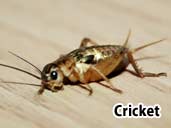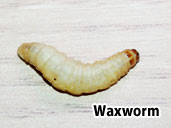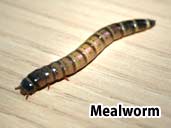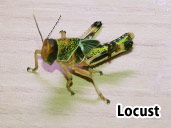Tokay Gecko Care Sheet written by Dan Davey for TheReptilian.co.uk
Common names : Tokay Gecko Scientific name: Gekko gecko DescriptionDescription: The Tokay is a large and impressive looking Gecko. They are the second largest Gecko species in the world, with the largest being the New Caledonian Giant Gecko. The natural coloration of the Tokay Gecko ranges from blue to grey with yellow or red spots. These Geckos also have the ability to brighten or darken their coloration in order to blend into their surrounding or to match their mood. The eyes of a Tokay Gecko are very unusual with vertically slit pupils. Size: Adult males generally grow to around 12-15 inches in length with adult females growing to a slightly smaller size of 8-11 inches. Life span: The lifespan of a Tokay Gecko is around 8 - 10 years although in captivity, with proper care, they can live for up to 10 years. Origin:Northeast India, Southeast Asia, Indonesia, New Guinea and the Philippines. Habitat: Tokay geckos live high in trees in the warm and humid environment of their native country. They are often encountered around human settlements where they prey upon insects which are attracted to the lighting in houses and public places. TemperamentTokay Geckos are often referred to as ‘the Pitbull of the Gecko world’. This is because of their aggressive and no fear attitude. Tokays will not hesitate to bite if they feel threatened. With many sharp teeth, powerful jaws and a vice-like grip, the bite of a Tokay is very painful and can inflict major damage. Whilst these geckos are very aggressive they, like most animals, would prefer to run for cover rather than attack. They will also give a ‘bark’ or a ’croaking’ sound which is a warning, this will generally be followed by a bite. Things to consider before purchasing a Leopard Gecko
HousingTokay Geckos are arboreal meaning they prefer a lifestyle off the ground. Therefore height is the most important factor of their enclosure. The vivarium/terrarium should be a minimum of roughly 45x45x60cm to house a single adult, although bigger is always better. Tokay Geckos are very territorial which means a very large enclosure must be provided if you wish to house multiple geckos. Your Vivarium should contain:SubstrateOrchid bark is the most effective and naturalistic substrate that can be used with Tokay Geckos. Alternatively, coconut fibre (Eco Earth) can be used. This substrate gives a natural look to the enclosure, it allows easy cleaning and also helps in keeping the humidity levels up. Paper towels can be used for simplistic set ups such as quarantine enclosures. DecorIt is vital that the Tokay geckos is provided with plenty of hiding places. This can be achieved by adding lots of greenery such as plants (real or fake), cork bar, plant pots and caves. They must also be provided with climbing obstacles such as vines, bamboo, logs and plants. Remember to always research which plants are suitable for the geckos enclosure before using them. Any objects collected from outdoors must be disinfected thoroughly before being added to the enclosure. WaterTokay geckos will rarely, if ever, drink from a water bowl. They prefer to drink water dropplets from leaves and wet surfaces. The best method of providing your gecko with water is to mist spay the enclosure with luke warm water. The gecko will then drink from the water droplets which have gathered in the enclosure. Humidity
The humidity levels within the enclosure must be kept between 60-90%. This can be achieved by misting the enclosure with warm water at least twice daily (once in the morning and once in the evening). Having an hygrometer within the enclosure will allow you to monitor the humidity more accurately. Both digital and dial hygrometers are readily available online and from reptile specialist shops.
Heating & LightingBeing nocturnal, Tokay geckos do not require UV lighting. Though they do need a heat source to achieve the desired temperature. Tokay geckos do well in an environment with the temperature ranging from 75-86°F. A heat lamp is the best method for heating the enclosure, a nocturnal red heat bulb is ideal for this nocturnal gecko. When using any heat source, it is vital that you use a Thermostat. This will keep the temperature at the right level and will be a very important and essential product to minimize the risk of over heating and fire hazards. A guard covering the bulb is also extremely important to ensure that the gecko does not come into contact with the bulb. Regularly monitoring the temperature inside the enclosure is also very important. The best and most accurate readings will come from a digital thermometer. General CareFeeding
Tokay Geckos are voracious feeders, they will eat a wide range of insects and also the occasional pinkie mouse. All insects should be gut loaded before feeding them to your gecko. Gutloading insects ensures that they are healthy and full of goodness which will then be passed onto your gecko. To ensure that your gecko receives all the necessary nutrients, it is advisable to supplement the insects. Dusting the insects every third to fifth feeding will be enough for an adult. Hatchling/young Geckos will benefit from supplemented insects with every feeding. CleaningA clean enclosure is a very important factor to ensure the best health for your Tokay Gecko. Being arboreal, Tokays will often defecate high up, and on the sides of the enclosure. This is easily removed with a damp piece of tissue. Spot cleaning should be done daily, any faeces or dead food items should be removed as soon as they’re noticed. A full and thorough clean of the enclosure and all its contents should be done at least once a month. This includes replacing the substrate and disinfecting all the equipment. Whilst cleaning the enclosure, the gecko should be moved to a temporary set up. Preferably in a dark and quit area to keep stress levels to a minimum. Shedding/SloughingYour Tokay Gecko will shed its skin many times throughout its life. Unlike snakes, lizards shed their skin in pieces. Geckos will regularly eat the skin as it comes off. Your Tokay may have trouble getting the skin off if the humidity levels in the enclosure aren’t high enough. If your Tokay seems to be having trouble removing the skin, try raising the humidity by mist spraying the enclosure more often with warm water. Keep a close eye on the Geckos feet, tail and eyes as these are the most common areas where shedding difficulties will occur. If you notice any stubborn pieces of skin left on the gecko, it may be time to intervene. The most effective way of removing this skin is to set up a temporary humid enclosure, a RUB (really useful box) is ideal. Fill the tub with damp paper towels or moss and sit it on a heat matt, ensure that no more than one third of the ground is covered. Keep a close eye on the temperature. Leave the gecko in this temporary set up over night. By the morning, the skin should be gone or soft enough to be easily removed. HandlingMost Tokay Geckos do not tolerate handling. These geckos are extremely defensive and will bite if they feel threatened. For this reason, it is best to handle these geckos only when absolutely necessary. When you do need to handle the gecko, be sure to use thick gloves as these geckos can give a very nasty bite. If gloves aren’t available, the best and safest way to handle a Tokay gecko is to restrain it by gently pinning the head and wrapping your fingers around the neck and body. This is very stressful to the gecko and should only be done when absolutely necessary. It is vital when picking the gecko up to be very gentle to ensure you don’t damage the toe pads. Whilst many people have managed to ‘tame’ their Tokay geckos, it is by no means an easy task. You must gain the geckos trust and show it that you are not a danger to it. This is a long process which will take many months, with no guarantee that it will work at all. SexingSexually mature Tokay geckos are fairly easy to sex when you know what you are looking for. The most effective way of sexing a Tokay is to look for the femoral pores. Males will have quite pronounced pores which make a V shape in-between the two hind legs where as females will have none. Some other methods to sex Tokays are as follows : Hemipenal bulges - Mature males will have hemipenal bulges at the base of the tale. This is not a very effective method to use as many females will also appear to have this bulge. Vocalisation - Mature male Tokay Geckos will let out a loud croaking noise which sounds like ‘to-keh‘, this is where the common name of Tokay comes from. They generally make these calls late at night and early in the morning. Size - Male Tokays are generally a fair bit bigger than the females, although this is not an accurate way of sexing Tokays. Due to most Tokay geckos being Wild Caught, it is very difficult to guess the age of the lizard. Therefore, what looks like a small female, could infact be a young male. BreedingTo breed Tokay Geckos you will obviously need one mature male and at least one mature female, although one male to several females will be fine. Tokays do not usually require any special conditioning in order to breed but it may help to do the following things. Lower the temperatures, lower the humidity levels and feed slightly less for roughly two months. After two months slowly start to increase the temperatures and amount of food, you should also start spraying the enclosure heavily every day. When the Geckos are ready to mate the male should be introduced to the females cage and the mating ritual should occur shortly. The male will move towards the female in quick, jerky movements, he will then hold onto the female by her neck during the mating process. Once mating has been witnessed, the male should be placed back into his own enclosure. This is to ensure that the male doesn’t harass the female too much. One to two months after mating, the female will deposit one or two small white eggs. She will stick these eggs to the side of the cage or to an object within the cage with a glue type substance. This makes it very difficult to remove the eggs for incubation. The eggs must not be forced off of any object, this will damage the eggs and will result in the eggs dying. If the eggs are laid on a small enough object, it is possible to remove the object and place it into the incubator. Some people have had success using a credit card to gently remove eggs from the side of a cage, this is a tricky process that must be done with extreme care. IncubationTo ensure the highest success rate, the eggs need to be artificially incubated. This is done by placing the eggs into a tub of moist vermiculite (make sure the eggs are not turned whilst moving them). This tub should then be placed into an incubator set to 80-84°f(27-29°C) Raising the young After anywhere between 65 - 200 days after incubation, the eggs will hatch. The hatchling Tokays will be roughly 4-6inches in length. They should be set up in an enclosure the same as the adults, just on a smaller scale. Ensure that any hatchlings living in the same enclosure are roughly the same size to avoid bullying. Feed the hatchlings on smaller sized insects. Each meal should be supplemented with a high quality calcium powder to ensure healthy bone development and growth. This should be done for the first year of the Geckos life. It may also be beneficial to the young geckos to provide slightly higher humidity levels to aid in the shedding cycle. Any more Questions?This care sheet is a simple step-by-step guide to successful Tokay Gecko keeping, but if you have anymore questions or need more specific information about the care of Tokay Geckos, please enter our forum. It is a useful resource where you can ask other members to share good practice and also talk about your experiences of being a Tokay Gecko keeper.
|
|

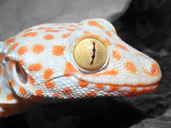
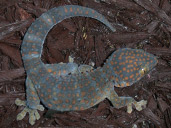
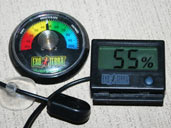 Tokay Geckos require a humid environment.
Tokay Geckos require a humid environment. 